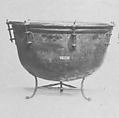Kettle Drum
Not on view
Pairs of kettledrums were traditionally paired with sets of evenly numbered trumpets and used in military and ceremonial functions. The drums were played with wooden mallets by players who were members of the musicians guild who carefully guarded the techniques, repertoire, and traditions associated with these instruments. Accordingly, guild kettledrummers and trumpeters were paid more than the typical soldiers. When used in ceremonial processions, the drums were typically draped in colorful banners and mounted and played on horseback. Often, kettledrummers in European courts and military units were black African men.
Technical description: Copper shells, larger timpano paired with 89.4.1339. Kettle measures 433 mm (17 inches) in height (with a stand of 4 inches) by 588 mm (23 inches) in diamter. Eight iron screws requiring a key to tune. Each screw is received by an iron mount, decorated like a downward pointing leaf with eight lobes, riveted to the shell. Iron rims with eyelets attached for the screws. Calfksin heads. Each drum has an internal metal funnel (schaltrictern) above the vent hole at the bottom of the drum. These are commonly found in seventeenth and eighteenth century drums from Germanic areas and were thought to improve the tone of the drum. (Jayson Kerr Dobney 2003)
Due to rights restrictions, this image cannot be enlarged, viewed at full screen, or downloaded.

